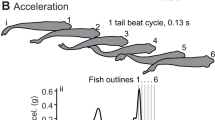Abstract
THERE has been great interest in the sea anemone Stomphia coccinea since its remarkable swimming response to the starfish Dermasterias imbricata was first discovered1. On contact with Dermasterias, this anemone rapidly detaches from the substrate and undergoes a series of swimming movements involving flexions of the column. The starfish Hippasteria spinosa2 and a nudibranch, Aeolidia papillosa3 also evoke swimming. Previous attempts to analyse this response physiologically were based on indirect observations of swimming induced by electrical stimulation. There were difficulties in explaining the coordination of the swimming response in terms of a single nerve net and it has been suggested that the swimming response is controlled by a separate system4. The electrical activity from sea anemones can be measured and correlated with various behaviour patterns5,6. Use of these techniques with S. coccinea has shown that a slow conduction system, quite distinct from the familiar through-conducting nerve net7 always becomes active when Dermasterias contacts Stomphia. This activity, it seems, triggers the entire swimming sequence.
This is a preview of subscription content, access via your institution
Access options
Subscribe to this journal
Receive 51 print issues and online access
$199.00 per year
only $3.90 per issue
Buy this article
- Purchase on Springer Link
- Instant access to full article PDF
Prices may be subject to local taxes which are calculated during checkout
Similar content being viewed by others
References
Yentsch, C. S., and Pierce, D. C., Science, 122, 1231–1233 (1955).
Sund, P. N., Q. Jl microsc. Sci., 99, 401–420 (1958).
Robson, E. A., J. exp. Biol., 38, 685–694 (1961).
Ross, D. M., and Sutton, L., J. exp. Biol., 41, 735–749 (1964).
Josephson, R. K., J. exp. Biol., 45, 305–319 (1966).
McFarlane, I. D., J. exp. Biol., 51, 377–385 (1969).
Pantin, C. F. A., J. exp. Biol., 12, 139–155 (1935).
Lawn, I. D., and McFarlane, I. D., J. exp. Biol. 64, 419–429 (1976).
McFarlane, I. D., and Lawn, I. D., J. exp. Biol., 57, 633–649 (1972).
Wilson, D. M., J. exp. Biol., 36, 526–532 (1959).
Ward, J. A., J. exp. Zool., 158, 357–364 (1965).
McFarlane, I. D., J. exp. Biol., 51, 387–396 (1969).
Lawn, I. D., J. exp. Biol., 63, 525–536 (1975).
Robson, F. A., Q. Jl microsc. Sci., 104, 535–549 (1963).
Author information
Authors and Affiliations
Rights and permissions
About this article
Cite this article
LAWN, I. Swimming in the sea anemone Stomphia coccinea triggered by a slow conduction system. Nature 262, 708–709 (1976). https://doi.org/10.1038/262708a0
Received:
Accepted:
Issue Date:
DOI: https://doi.org/10.1038/262708a0
This article is cited by
-
From nerve net to nerve ring, nerve cord and brain — evolution of the nervous system
Nature Reviews Neuroscience (2016)
-
The physiological control of feeding in corals: a review
Hydrobiologia (1991)
-
The senses of sea anemones: responses of the SS1 nerve net to chemical and mechanical stimuli
Hydrobiologia (1991)
Comments
By submitting a comment you agree to abide by our Terms and Community Guidelines. If you find something abusive or that does not comply with our terms or guidelines please flag it as inappropriate.



